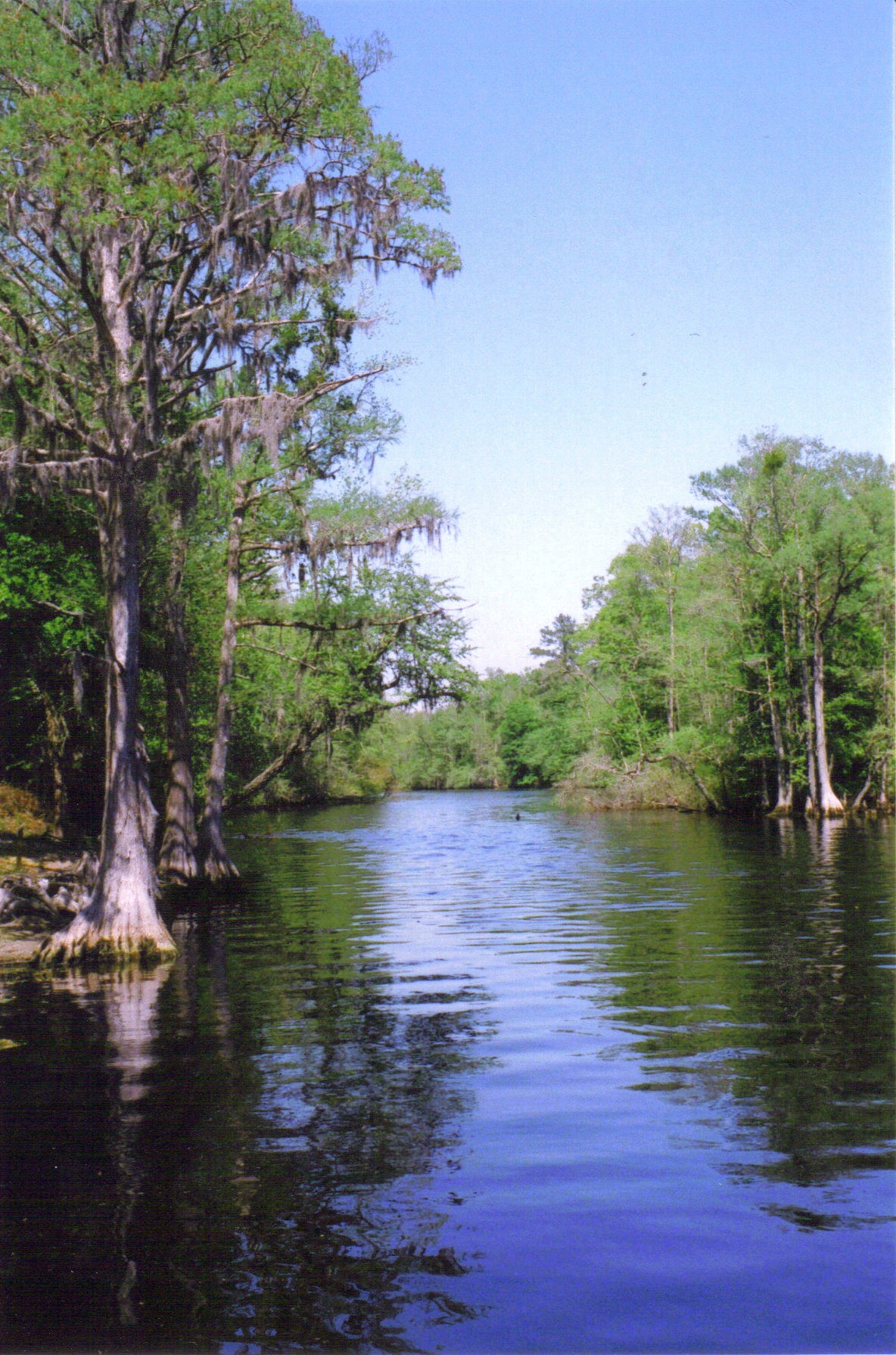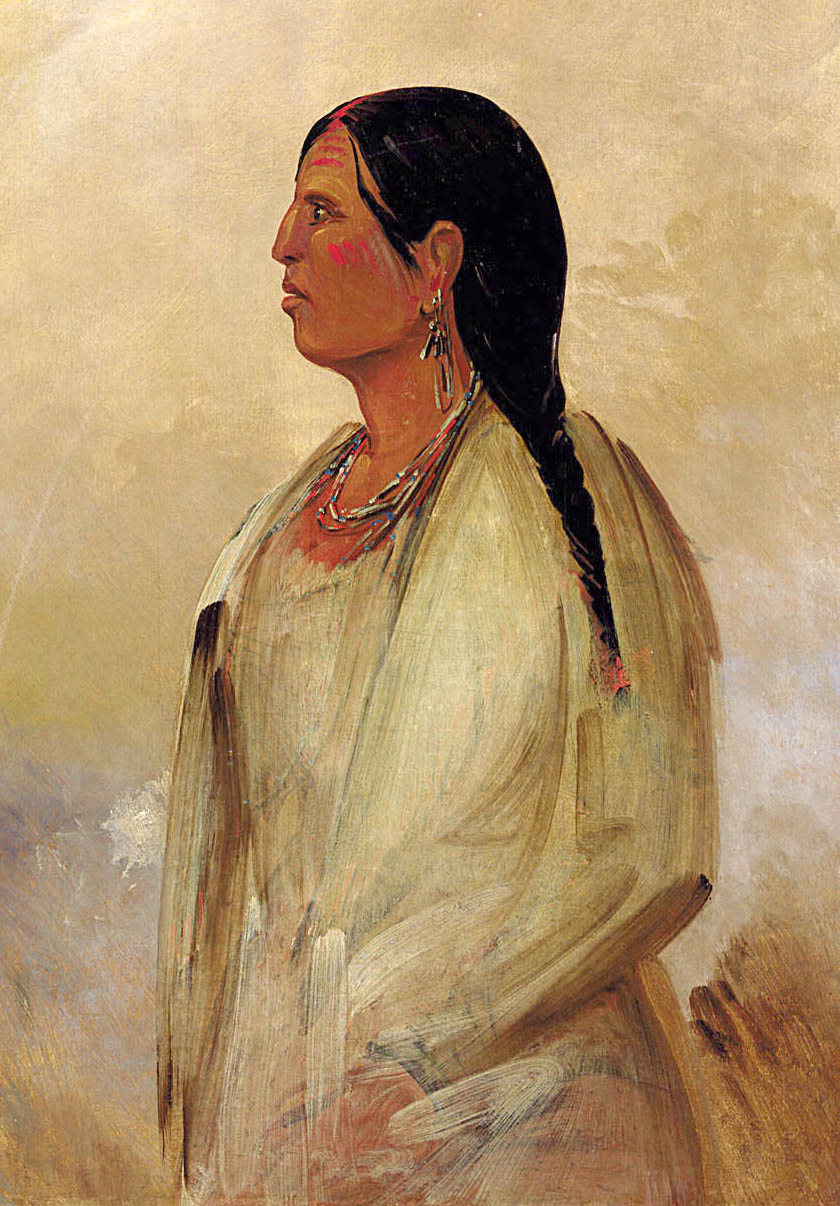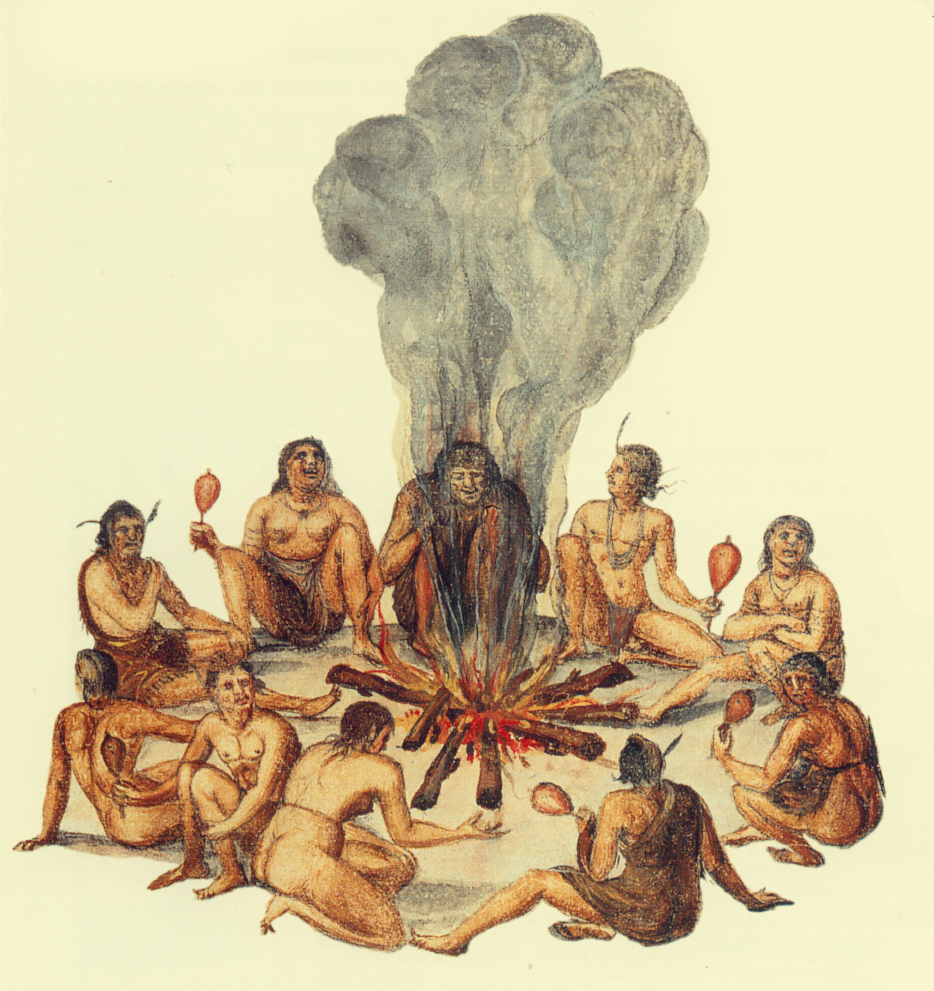|
Lumbee
The Lumbee, also known as People of the Dark Water, are a mixed-race community primarily located in Robeson County, North Carolina, which claims to be descended from myriad Indigenous peoples of the Southeastern Woodlands who once inhabited the region. The Lumbee have been shown to have connections with other tri-racial isolate groups, such as the Melungeons, using historical documents. The Lumbee take their name from the Lumber River, which winds through Robeson County. Pembroke, North Carolina, in Robeson County, is their economic, cultural, and political center. According to the 2000 United States census report, 89% of the population of the town of Pembroke identified as Lumbee; 40% of Robeson County's population identified as Lumbee. The Lumbee Tribe was recognized by North Carolina in 1885. In 1956, the U.S. Congress passed the Lumbee Act, which recognized the Lumbees as being American Indians but denied them the benefits of a federally recognized tribe. The three ... [...More Info...] [...Related Items...] OR: [Wikipedia] [Google] [Baidu] |
Robeson County, North Carolina
Robeson County ( )Talk Like a Tarheel , from the North Carolina Collection website at the . Retrieved August 16, 2023. is a in the southern part of the U.S. state of and is its largest county by land area. Its |
Pembroke, North Carolina
Pembroke is a town in Robeson County, North Carolina, United States. It is about 90 miles inland and northwest from the Atlantic Coast. The population was 2,823 at the 2020 census. The town is the seat of the state-recognized Lumbee Tribe of North Carolina, as well as the home of the University of North Carolina at Pembroke. Geography According to the United States Census Bureau, the town has a total area of , all land. Demographics 2020 census As of the 2020 United States census, there were 2,823 people, 879 households, and 529 families residing in the town. 2000 census According to the 2000 census, there were 2,399 people, 961 households, and 611 families residing in the town. The population density was . There were 1,043 housing units at an average density of . The racial makeup of the town was: * 88.90% Native American * 8.15% White * 2.20% African American * 0.54% Asian * 0.00% Pacific Islander * 0.53% from other races * 0.70% from two or more races. * Hispan ... [...More Info...] [...Related Items...] OR: [Wikipedia] [Google] [Baidu] |
Native American Identity In The United States
Native American identity in the United States is a community identity, determined by the tribal nation the individual or group belongs to. While it is common for non-Natives to consider it a racial or ethnic identity, for Native Americans in the United States it is considered a political identity, based on citizenship and immediate family relationships. As culture can vary widely between the 574 extant federally recognized tribes in the United States, the idea of a single unified "Native American" racial identity is a European construct that does not have an equivalent in tribal thought. While some groups and individuals self-identify as Native American, self-identification on its own does not make one eligible for membership among recognized tribes. There are a number of different factors which have been used by non-Natives to define "Indianness," and the source and potential use of the definition play a role in what definitions have been used in their writings, including cultu ... [...More Info...] [...Related Items...] OR: [Wikipedia] [Google] [Baidu] |
Melungeon
Melungeon ( ) (sometimes also spelled Malungean, Melangean, Melungean, Melungin) was a slur historically applied to individuals and families of mixed-race ancestry with roots in colonial Virginia, Tennessee, and North Carolina who were primarily descended from free people of color and white settlers. In the late 20th century, the term was reclaimed by descendants of these families, especially in southern Appalachia. Despite this mixed heritage, many modern Melungeons pass as white, as did many of their ancestors. Many groups have historically been referred to as Melungeon, including the Melungeons of Newman's Ridge, the Lumbee Tribe of North Carolina, the Chestnut Ridge people, and the Carmel Indians. Free people of color in colonial Virginia were predominantly of African and European descent; however, many families also had varying amounts of Native American and East Indian ancestry. Some modern researchers believe that early Atlantic Creole slaves, descended from o ... [...More Info...] [...Related Items...] OR: [Wikipedia] [Google] [Baidu] |
Lumber River
The Lumber River, sometimes referred to as the Lumbee River, is a river in south-central North Carolina in the flat Coastal Plain. European settlers first called the river Drowning Creek, which is still used as the name of its headwater. The waterway known as the Lumber River extends downstream from the Scotland County- Hoke County border to the North Carolina-South Carolina border. Soon after crossing into South Carolina, the Lumber River flows into the Little Pee Dee River, which flows into the Pee Dee River, or Great Pee Dee River. Finally, the combined waters flow into Winyah Bay and the Atlantic Ocean. In 1989, the river was designated as a " Natural and Scenic River" by the North Carolina General Assembly. In addition, it is the only blackwater river in North Carolina to be designated as a National Wild and Scenic River by the Department of the Interior. In 2010, the Lumber River was voted one of North Carolina’s Ten Natural Wonders, the result of an on-line contest ... [...More Info...] [...Related Items...] OR: [Wikipedia] [Google] [Baidu] |
Cheraw
The Cheraw people, also known as the Saraw or Saura,Sebeok, Thomas Albert''Native Languages of the Americas, Volume 2.''Plenum Press, 1977: 251. were a Siouan-speaking tribe of Indigenous people of the Southeastern Woodlands,Swanton''The Indians of the Southeastern United States'' p. 109. in the Piedmont area of North Carolina near the Sauratown Mountains, east of Pilot Mountain and north of the Yadkin River. They lived in villages near the Catawba River.Rudes et al., "Catawba and Neighboring Groups", p. 310 Their first European and African contact was with the Hernando De Soto Expedition at the site of Joara in 1540. The early English explorer John Lawson included them in the larger eastern-Siouan confederacy, which he called "the Esaw Nation."''Handbook of the American Indian North of Mexico'', 1906 After attacks in the late 17th century and early 18th century, they moved to the southeast around the Pee Dee River, where the Cheraw name became more widely used. They becam ... [...More Info...] [...Related Items...] OR: [Wikipedia] [Google] [Baidu] |
American Indian English
American Indian English or Native American English is a diverse collection of English dialects spoken by many American Indians and Alaska Natives, notwithstanding indigenous languages also spoken in the United States, of which only a few are in daily use. For the sake of comparison, this article focuses on similarities across varieties of American Indian English that unite it in contrast to a "typical" English variety with standard grammar and a General American accent. Pronunciation Vowels The phonemic contrasts between front vowels in standard English are not always maintained in American Indian dialects of English. For example, Navajo English may have , , or mergers, particularly word-medially. Isleta English maintains these contrasts, though according to different patterns than standard English. In the English of all Colorado River Indians (namely, Mohave, Hopi, and Navajo), front vowels tend to shift, often one degree lower than standard English vowels. Old spe ... [...More Info...] [...Related Items...] OR: [Wikipedia] [Google] [Baidu] |
Tuscarora People
The Tuscarora (in Tuscarora language, Tuscarora ''Skarù:ręˀ'') are an indigenous people of the Northeastern Woodlands in Canada and the United States. They are an Iroquoian Peoples, Iroquoian Native Americans in the United States, Native American and First Nations in Canada, First Nations people. The Tuscarora Nation, a federally recognized tribe, is based in New York (state), New York, and the Tuscarora First Nation is one of the Six Nations of the Grand River in Ontario. Prior to European contact, the Tuscarora lived in the Carolinas along the Roanoke River, Roanoke, Neuse River, Neuse, Tar River, Tar, and Pamlico River, Pamlico Rivers.F.W. Hodge, "Tuscarora" ''Handbook of American Indians'', Washington, DC: Smithsonian Institution, 1906, at AccessGenealogy, accessed 28 Oct. 2009 [...More Info...] [...Related Items...] OR: [Wikipedia] [Google] [Baidu] |
Hatteras Indians
The Hatteras Indians were a tribe of Native Americans in the United States who lived in the North Carolina Outer Banks. They inhabited a village on what is now called Hatteras IslandJohn Reed Swanton, ''The Indian Tribes of North America'', 80. called Croatoan. Name The name ''Hatteras'' was first used by the English explorer John Lawson. Lawson was writing a book where he mentioned the Hatteras Indians for the first time. Although the meaning of ''Hatteras'' is unknown, the people from that island were known as "the people of shallow water". John Lawson believed that they may have been the Croatans. History The Hatteras first had contact with English settlers, notably John White, in 1587, and were gone by the mid-18th century. In 1701, their population was estimated to be 80 people. During the 1711 Tuscarora War The Tuscarora War was fought in North Carolina from September 10, 1711, until February 11, 1715, between the Tuscarora people and their allies on one side a ... [...More Info...] [...Related Items...] OR: [Wikipedia] [Google] [Baidu] |
Indigenous Peoples Of The Southeastern Woodlands
Indigenous peoples of the Southeastern Woodlands, Southeastern cultures, or Southeast Indians are an ethnographic classification for Native Americans who have traditionally inhabited the area now part of the Southeastern United States and the northeastern border of Mexico, that share common cultural traits. This classification is a part of the Eastern Woodlands. The concept of a southeastern cultural region was developed by anthropologists, beginning with Otis Mason and Franz Boas in 1887. The boundaries of the region are defined more by shared cultural traits than by geographic distinctions.Jackson and Fogelson 3 Because the cultures gradually instead of abruptly shift into Plains, Prairie, or Northeastern Woodlands cultures, scholars do not always agree on the exact limits of the Southeastern Woodland culture region. Shawnee, Powhatan, Waco, Tawakoni, Tonkawa, Karankawa, Quapaw, and Mosopelea are usually seen as marginally southeastern and their traditional lands represen ... [...More Info...] [...Related Items...] OR: [Wikipedia] [Google] [Baidu] |
North Carolina
North Carolina ( ) is a U.S. state, state in the Southeastern United States, Southeastern region of the United States. It is bordered by Virginia to the north, the Atlantic Ocean to the east, South Carolina to the south, Georgia (U.S. state), Georgia to the southwest, and Tennessee to the west. The state is the List of U.S. states and territories by area, 28th-largest and List of U.S. states and territories by population, 9th-most populous of the List of states and territories of the United States, United States. Along with South Carolina, it makes up the Carolinas region of the East Coast of the United States, East Coast. At the 2020 United States census, 2020 census, the state had a population of 10,439,388. Raleigh, North Carolina, Raleigh is the state's List of capitals in the United States, capital and Charlotte, North Carolina, Charlotte is its List of municipalities in North Carolina, most populous and one of the fastest growing cities in the United States. The Charl ... [...More Info...] [...Related Items...] OR: [Wikipedia] [Google] [Baidu] |








